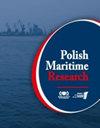Experimental Study on Vibration of a Rotating Pipe in Still Water and in Flow
IF 2
3区 工程技术
Q2 ENGINEERING, MARINE
引用次数: 0
Abstract
Abstract To illustrate the vibration characteristics of a rotating pipe in flow, experiments were conducted for a pipe in flow, a rotating pipe in still water and a rotating pipe in flow. For the pipe in flow without rotation, the trajectory diagram is ‘8’ shaped. For the rotating pipe in still water, a multiple frequency component was induced, and a ‘positive direction whirl’ was found. For the flow and rotation, at a flow velocity of 0.46 m/s, the vibration is dominated by the combination of flow and rotation. With an increase in rotating frequency, the trajectory of the rotating pipe varies from an ‘8’ shape to a circular shape and the ‘reverse direction whirl’ is induced, which is different from ‘positive direction’ in still water. The vibration frequency ratio increases uniformly with flow velocity. At a flow velocity of 1.02 m/s, at which the frequency is close to the theoretical natural frequency, the vibration frequency ratio is f*≈1. Predominantly governed by vortex-induced vibration (VIV), the vibration behavior of a rotating pipe subjected to fluid flow conditions has been found to exhibit complete vanishing of whirl. The vibration characteristics of a rotating pipe in flow are studied by the experiments which is benefit for structural drilling design.旋转管在静水和流动中的振动实验研究
摘要为了说明流动中旋转管道的振动特性,分别对流动中的管道、静水中的旋转管道和流动中的旋转管道进行了振动实验。对于不旋转流动的管道,轨迹图为“8”形。对于静水中的旋转管道,产生了一个多频分量,得到了一个“正方向旋流”。对于流动和旋转,在流速为0.46 m/s时,振动以流动和旋转组合为主。随着旋转频率的增加,旋转管的运动轨迹由“8”形变为圆形,产生与静水中“正方向”不同的“反向旋流”。振动频率比随流速均匀增大。当流速为1.02 m/s,频率接近理论固有频率时,振动频率比为f*≈1。在流体流动条件下,旋转管道的振动行为主要受涡激振动(VIV)控制,表现为旋涡完全消失。通过实验研究了旋转管道在流动中的振动特性,为结构钻孔设计提供了理论依据。
本文章由计算机程序翻译,如有差异,请以英文原文为准。
求助全文
约1分钟内获得全文
求助全文
来源期刊

Polish Maritime Research
工程技术-工程:海洋
CiteScore
3.70
自引率
45.00%
发文量
20
审稿时长
>12 weeks
期刊介绍:
The scope of the journal covers selected issues related to all phases of product lifecycle and corresponding technologies for offshore floating and fixed structures and their components.
All researchers are invited to submit their original papers for peer review and publications related to methods of the design; production and manufacturing; maintenance and operational processes of such technical items as:
all types of vessels and their equipment,
fixed and floating offshore units and their components,
autonomous underwater vehicle (AUV) and remotely operated vehicle (ROV).
We welcome submissions from these fields in the following technical topics:
ship hydrodynamics: buoyancy and stability; ship resistance and propulsion, etc.,
structural integrity of ship and offshore unit structures: materials; welding; fatigue and fracture, etc.,
marine equipment: ship and offshore unit power plants: overboarding equipment; etc.
 求助内容:
求助内容: 应助结果提醒方式:
应助结果提醒方式:


